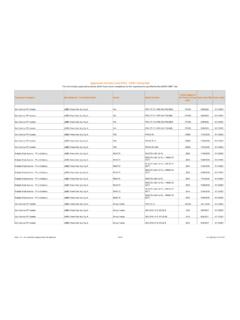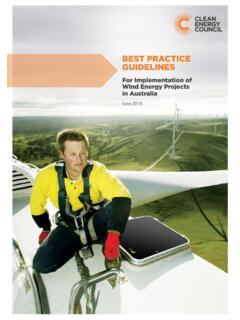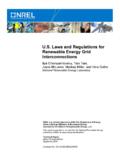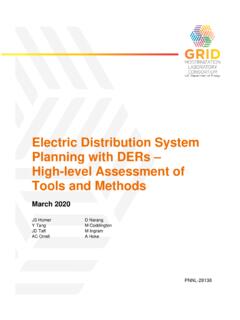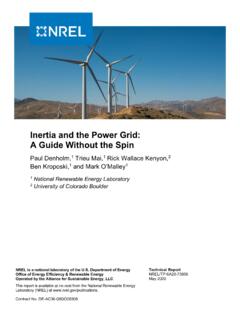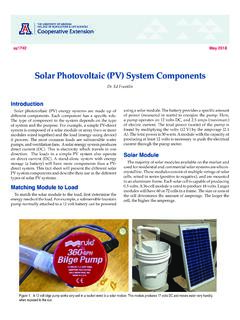Transcription of ROADMAP FOR A RENEWABLE ENERGY FUTURE
1 ROADMAP FOR A RENEWABLE ENERGY FUTUREFEDERAL ELECTION POLICY RECOMMENDATIONSA ustralia s clean ENERGY resources are the envy of the world. At the dawn of a new decade and in response to the profound economic impact of COVID-19, Australia has the opportunity to exploit these natural advantages to bring down the cost of electricity for households and businesses and position the country as the natural home of ENERGY -intensive industries in the Asia Pacific. Clean ENERGY has delivered an enormous economic boost to Australia during the past years as a result of unprecedented levels of investment in large-scale wind, solar and storage, as well as record levels of installation of rooftop solar and household battery ENERGY can create thousands of new jobs, empower consumers, bring economic activity to regional communities, lower power prices and create the smart infrastructure of the FUTURE that can cement Australia s place as a global clean ENERGY superpower.
2 More RENEWABLE ENERGY investment is crucial for Australia to prepare for the inevitable exit of ageing coal generators over the coming decade, requiring the construction of at least 30 GW of solar and wind to replace coal generation by 2040. This is just the very beginning of Australia s enormous clean ENERGY opportunity. According to former Chief Scientist, Dr Alan Finkel, if we were to power an all-electric Australia we would need to increase wind and solar ENERGY production in Australia by around 20 times to meet all our domestic ENERGY needs with RENEWABLE electricity. And if we were to embrace the opportunity to develop a RENEWABLE hydrogen industry that rivals our liquified natural gas export sector, we would need another 700 GW of installed wind and solar capacity over the next 30 years. The opportunity is staggering in while there has been massive investment in clean ENERGY projects over the past five years, this investment has slowed dramatically since 2019 due to the expiry of the RENEWABLE ENERGY Target, lower electricity prices, the inadequacy of Australia s transmission network and significant barriers to grid connection.
3 The long-term fundamentals of investment in clean ENERGY remain strong and compelling, and the current circumstances highlight the need for a strong and coordinated strategy to better manage the transition to a clean ENERGY system and unlock the enormous potential at hand. Strong government leadership is crucial to manage the transition and facilitate private investment in low-cost clean ENERGY , turbo-charging economic activity and job creation across Australia and accelerating our transition to becoming a clean ENERGY can meet our domestic electricity demand with clean ENERGY by can be achieved by a comprehensive ROADMAP comprising nine key elements:1 Electrify Australia: power the Australian economy and industry with wind, solar , hydro, bioenergy and battery customers and communities to make the switch to clean a strong, smart, 21st-century electricity the creation of quality clean ENERGY jobs and a local supply greater support and certainty for coal communities and industry as the phase-out of coal generation Australia s ENERGY market and its governance for the clean ENERGY clean ENERGY Australian industries using clean ENERGY .
4 9 Put Australia on a path to becoming a global clean ENERGY superpower that exports RENEWABLE ENERGY to Asia and , CLEAN ENERGY SUPERPOWERROADMAP FOR A RENEWABLE ENERGY FUTUREPOLICY RECOMMENDATIONS Set a clear target for Australia to be powered by clean ENERGY by 2030. Commit Australia to net-zero emissions before 2050 and set strong interim targets for 2030 consistent with the latest climate science. Introduce strong, enduring clean ENERGY policy mechanisms to deliver this target and coordinate state-based policy mechanisms. These could be in the form of a RENEWABLE ENERGY scheme such as an extended RENEWABLE ENERGY Target, a New ENERGY Target, revitalising the National ENERGY Guarantee or strengthening the existing safeguard mechanism. Establish a framework to ensure that voluntary carbon commitments from businesses can be delivered through clean ENERGY necessary confidence for private investors and put Australia on a clear pathway to an entirely RENEWABLE ENERGY system by only could Australia meet its domestic electricity demand with clean ENERGY and storage by 2030, but it has the potential to greatly expand its supply to electrify other sectors of the economy currently dependent on fossil fuels (such as transport and heavy industry), and to export clean ENERGY to the world.
5 An immediate target should recognise and guide Australia to leverage the leadership of state and territory governments and set Australia on a path to meet all of our electricity demand from clean ENERGY sources by 2030. In 2018, $ billion in private investment was put into large-scale RENEWABLE ENERGY generation, adding 6 GW to the national grid. In 2020, that investment figure dropped to $ billion, accounting for only GW of new capacity. For a rapid transition to take place by 2030, the Australian ENERGY Market Operator s Integrated System Plan modelling shows that GW of utility-scale and behind-the-meter capacity will need to be added every year from 2022-2030 (inclusive of 2030). There is an enormous pipeline of potential large-scale wind, solar , hydro and storage projects throughout Australia. Bioenergy can also make a contribution to Australia s FUTURE ENERGY supply, making beneficial use of waste and reducing greenhouse gas emissions.
6 Unlocking this investment is critical to ensuring a reliable, flexible and low-cost ENERGY system as Australia s coal-fired power continues to become less reliable and levels of new investment in RENEWABLE ENERGY and ENERGY storage since 2017 demonstrate that there is an enormous appetite for private investment in clean ENERGY in , a range of barriers are acting to stifle investment and undermine the ambition to meet Australia s domestic electricity demand with clean ENERGY by 2030. Federal clean ENERGY policy has been politicised and undergone significant change over the past decade. This combined with a range of other challenges outlined in this ROADMAP has added to substantial policy uncertainty for clean ENERGY investors. State and territory governments have attempted to fill this policy and leadership void by introducing a range of policy mechanisms intended to increase investment confidence and facilitate the shift to clean ENERGY .
7 These initiatives have played an important role, but are no substitute for a clear and strong federal clean ENERGY target and policy mechanisms that have enduring bipartisan support. This would provide #1 ELECTRIFY AUSTRALIA: POWER THE AUSTRALIAN ECONOMY AND INDUSTRY WITH WIND, solar , HYDRO, BIOENERGY AND BATTERY STORAGER ooftop solar achieved record levels of installation in 2019 and was driven by very strong consumer demand accompanied by increasing cost-effectiveness higher retail electricity prices combined with lower costs for solar systems and customer understanding and interest in solar power as a way of managing power prices and contributing to climate change action. While the business case for rooftop solar is very strong for many Australians, barriers remain for niche applications and customer segments, such as renters and low-income households or financing commercial and community-scale systems.
8 Household batteries have become increasingly popular, with 23,796 Australian homes installing a battery in 2020. While the cost of household batteries continues to fall, the upfront cost of systems remains a barrier for most Australians. There is a role for governments to incentivise battery solutions and drive innovation in business models to support the increased customer uptake of household battery systems. POLICY RECOMMENDATIONS Set a target for every suitable and appropriate Australian building to have rooftop solar and a household battery by 2030. Implement a campaign to promote the uptake of GreenPower among Australian ENERGY customers, particularly where GreenPower is a more efficient or effective solution than rooftop solar . Introduce a household battery program to reduce the upfront cost of household batteries and accelerate the deployment and development of the household battery industry.
9 Commit to funding a solar system and battery in every public building, fire station, police station, hospital and school in Australia. Introduce a government program to support the uptake of rooftop solar in low-income households, including tax concessions for landlords, an upfront rebate program and low-interest loans. Establish a program to provide funding and technical support to community ENERGY projects across Australia.#2 EMPOWER CUSTOMERS AND COMMUNTIES TO MAKE THE SWITCH TO CLEAN ENERGYPOLICY RECOMMENDATIONS Establish a $20 billion fund to leverage private sector investment in grid infrastructure, including priority transmission projects as set out in the 2020 Integrated System Plan. This includes Project EnergyConnect, HumeLink, Marinus Link and the Central-West Orana RENEWABLE ENERGY Zone Transmission Link. Reform planning processes to support the efficient location of ENERGY storage.
10 Expand funding to support innovation in grid-forming inverters, battery storage and pumped hydro generation. Reform the regulatory investment test for transmission to ensure it is fit-for-purpose.#3 BUILD A STRONG, SMART, 21ST-CENTURY ELECTRICITY NETWORKT here is a clear role for government to both accelerate the reform of this regulatory framework, while also immediately underpinning the capital-intensive private investment in transmission. A fund should be established to support the build out of major transmission assets to support the transition and decarbonisation of the ENERGY sector. This is central to supporting the secure operation of the power system and to enable the ongoing reliable supply of ENERGY to customers. New market frameworks must be developed to harness the capabilities of inverter-based generation, batteries and other forms of ENERGY storage.



